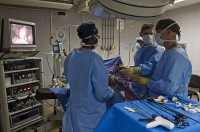
20 Oct Time for a Change in Endoscopic Modality of GI Cancer Screening
MedicalResearch.com Interview with:
加藤元嗣 Mototsugu KATO MD PhD
院長 独立行政法人国立病院機構函館病院
Director, National Hospital Organization
Hakodate National Hospita
MedicalResearch.com: What is the background for this study?
Response: The primary goal of upper gastrointestinal (GI) endoscopic examination is to detect neoplastic lesions in the pharynx, esophagus, and stomach. However, early-stage lesions may frequently be overlooked by conventional white light endoscopy. Since the recent launch of image-enhanced endoscopy, many studies have evaluated its efficacy in diagnosing upper GI neoplasms as well. Linked color imaging (LCI )emphasizes the difference in color to make it easier to detect neoplastic lesions. The aim of this trial is to compare the performance of LCI with white light imaging in detecting upper GI tract neoplastic lesions.
MedicalResearch.com: What are the main findings?
Response: This randomized clinical study demonstrated that LCI can detect neoplastic lesions in the upper GI tract (pharynx, esophagus, and stomach) 1.67 times (CI, 1.12 to 2.50) more frequently than conventional white light imaging (WLI). This result indicates that many neoplastic lesions are being overlooked by conventional white light endoscopy performed in routine clinical practice.
MedicalResearch.com: What should readers take away from your report?
Response: Our manuscript provides very important messages regarding endoscopic modality for upper GI cancer screening. The use of LCI can be recommended by switching white light imaging use in screening for upper GI cancer because of reducing missed neoplastic lesions.
MedicalResearch.com: What recommendations do you have for future research as a result of this work?
Response: The experts in upper GI endoscopy performed the examinations on populations at high risk for neoplasms in the pharynx, esophagus, or stomach. It is unclear whether these examinations, if performed by general clinicians on an average population, would yield results similar to those obtained by the highly experienced endoscopists in this study.
MedicalResearch.com: Is there anything else you would like to add?
Response: The time for a change in endoscopic modality of GI screening has come
Citation:
Linked Color Imaging Focused on Neoplasm Detection in the Upper Gastrointestinal Tract. Annals of Internal Medicine 0;0 [Epub ahead of print 20 October 2020]. doi:https://doi.org/10.7326/M19-2561
[subscribe]
Last Modified: [last-modified]
The information on MedicalResearch.com is provided for educational purposes only, and is in no way intended to diagnose, cure, or treat any medical or other condition. Always seek the advice of your physician or other qualified health and ask your doctor any questions you may have regarding a medical condition. In addition to all other limitations and disclaimers in this agreement, service provider and its third party providers disclaim any liability or loss in connection with the content provided on this website.
Last Updated on October 20, 2020 by Marie Benz MD FAAD
